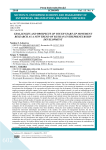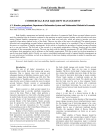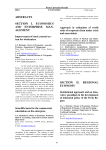Вестник Пермского университета. Серия: Экономика @economics-psu
Статьи журнала - Вестник Пермского университета. Серия: Экономика
Все статьи: 717

Статья научная
The revision of the role of entrepreneurship has led to a reassessment of the importance of entrepreneurial activity and entrepreneurial intentions as sources of startup movement in Russia. This fact determines the relevance of the youth startup movement study as a new trend in the youth entrepreneur environment. It also stresses the importance to reveal factors that promote the development of the movement and factors that restrict the development of Russian startup companies that require government and public support. In this regard, the purpose of the original research is to work out methodological and methodical tools to identify reasons, challenges and consequences of the startup movement development as it will allow us to create more efficient mechanisms of its promotion in Russia. The study is methodologically based on an interdisciplinary approach that reveals a set of economic, social, psychological and cultural factors that characterize the behavior of young people involved in the startup community. To identify the trends and restrictions of the youth startup movement development in Russia desk and field studies of founders and representatives of 150 Russian youth startup companies participating in the Startup Village (Skolkovo, 2018) Exhibition have been conducted and 109 websites of the corresponding startup companies have been investigated. As a result of the expert survey and the content-analysis of the websites the importance of startup companies for the development of the entrepreneur activity of the youth has been revealed. The key challenges for the development of youth startup companies have been identified. Among the most significant challenges are the lack of the demand for innovation technologies and products at the markets, low quality of management decisions, the lack of professional knowledge when developing or promotion innovation products and technologies, insufficient financial and state support at early stages of project implementation, low government response for startup initiatives, low effectiveness and efficiency of startup activity. The elaboration of programs and measures of the state youth policy may become one of the mechanisms for the development and support of the youth startups. The measures may become the foundation for the technologies that will involve young people in the startup movement taking into account their inclination and willingness for entrepreneur activity. We believe that the study of the socio-economic structure of the startup movement, the mechanisms of its increase and the reasons for leaving the startup community are a promising area of future research.
Бесплатно

Commercial bank liquidity management
Статья научная
Bank liquidity management and optimal resource allocation of commercial bank Nostro accounts balances receive much less attention from the scientists compared to the questions on capital structure, funding, credit risk analysis and stress testing. Optimal liquidity management is a way to lower bank costs and risks, which are going to increase over time, especially when money markets are dry of free funds. There are two sides of the issue to be analyzed. The optimal resource allocation and corresponding accounts balances optimization are the first points to be considered. Then we should look at the process as a problem of liquidity requirements. In this article we formulate the procedure of optimal resource allocation up to a one-year horizon. The first part of the research is a one-month optimization: efficiency function and the related constraints of the corresponding accounts. The next step deals with the liquidity requirements (N3 and NSFR) restrictions, and balance sheet aggregation, and its influence on the liquidity requirements. With this in mind we develop inequations to specify long-term liquidity deficit. Finally, we create a consolidated mathematic model of optimal liquidity management up to a one-year horizon. In addition, we look at an alternative of short-term funding with premium to market to smoothen non-planned funds outflow.
Бесплатно

Статья научная
The paper gives a review of theoretical, methodological and applied conclusions and results obtained by the academic school “Competitiveness and management of socio-economic systems development: synthesis of hierarchical and institutional modeling of socio-economic systems”. The school was founded by Professor Yu.K. Persky. The research conducted by academic economists from Perm is focused on the problems of interlevel analysis of socioeconomic systems on the basis of the hierarchical and institutional approaches. The instrumentarium suggested proves that hierarchical and institutional interrelations, being ignored by traditional neoclassical theory, should be thoroughly studied. It also emphasizes the necessity for system research into the problem of competitiveness and management in terms of the economic hierarchy: at nano, mini, micro, meta, meso, macro and mega levels. The key elements that research within the framework of the academic school focuses on are the following: an integral model of hierarchal economy taking into account interlevel interaction and institutional structuring; modeling of direct, reverse, vertical and horizontal interrelations, their typology and evaluation of their influence at different hierarchy levels; improvement of the state economic policy; issues of asymmetric distribution and circulation of information flows and their optimization; the problem of harmonization of economic relations participants’ interests and etc. Special attention is given to regional studies of Perm scientists, devoted to theory, methodology and practical aspects of the regional economy’s development with the aim of improving economic policy of the region. In particular, the results of identification and evaluation of clusters in the region’s economy are given, the urgent necessity of forming an integral model of the territory’s cluster spatial development is justified. Moreover, the article suggests directions of developing a competitive innovative system in the region and shows the opportunities of strategic management processes modeling and implementation of effective international economic activity and development of market infrastructure for regional economy. Thus, the synthesis of hierarchical and institutional analysis made it possible to develop methodical and methodological basis for the research into hierarchically organized national and regional economies, separate enterprises, industrial branches and technological complexes as well as to work out models of markets for goods and resources and to structure and design different institutional systems and socio-economic processes.
Бесплатно


















